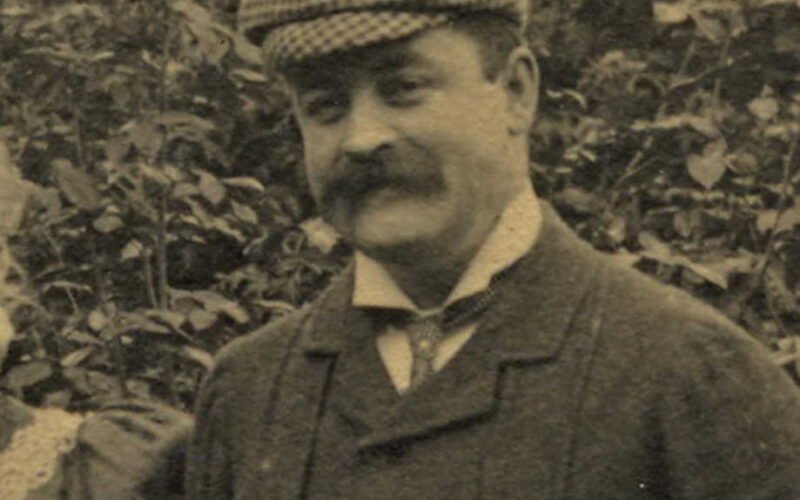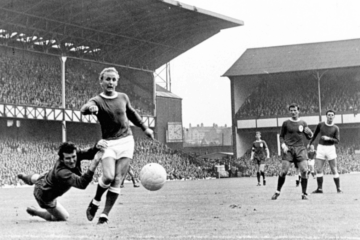Jamie Yates
Can you name the player who made only three known appearances for Everton, started as an outfield player in two of them and played in goal in the other. Oh, and captained the team on all three occasions? If it helps, the individual in question was a 17-year-old trainee accountant from London who later went on to seek his fortune with the East India Company.
Need a few more clues?
Sidney Albert Chalk may not be a name familiar to many, but he goes down in history as the first recorded captain of an Everton football team, for the match held on Saturday, 10 January 1880, on the pitch of the Birkenhead Association team. As was the case in virtually every other aspect of the Association game, tactics were in their infancy in those days, but Sidney Chalk appears to have filled something resembling a half-back or midfield role.
The match ended in a 2-0 defeat for Everton, an unfortunate scoreline which would be repeated in all three fixtures in which Sidney Chalk is known to have played. A month later, on Saturday, 7 February 1880, St. David’s of Bootle were the visitors to Stanley Park. A further month thereafter, on Saturday, 6 March 1880, Birkenhead Association were the visitors in a return fixture. This was the game in which Chalk filled in between the goalposts, twice suffering the ignominy of having to retrieve the ball after it had been bundled past him.
Chalk might well have made a few more appearances for the fledgling football club on the newly established green expanses of Stanley Park, Liverpool 4, in the early months of 1880, including fixtures where Everton actually managed to score a goal or two and even win! Alas, team line-ups have not survived for all those early friendly matches, so his record goes down as played three, lost three, scored nil, conceded six. If captain’s armbands were a thing in those early days, then Chalk could’ve been forgiven for flinging his in the Mersey.
Sidney Albert Chalk was born on Monday, 30 June 1862, at home at 34 Rutland Street, just off Brompton Road in the affluent Knightsbridge district of London. The Chalk family lived a five-minute walk from Hyde Park to the north. The rapidly expanding Harrods department store, which had begun to develop its flagship premises just 13 years earlier, stood a similar distance to the east. His name appears as Albert Sidney Chalk on his death certificate, though never anywhere else, although the spelling of his forename fluctuated in various records and publications between Sidney and Sydney throughout his life. Houses on Rutland Street today can go on the market for well over four million pounds.

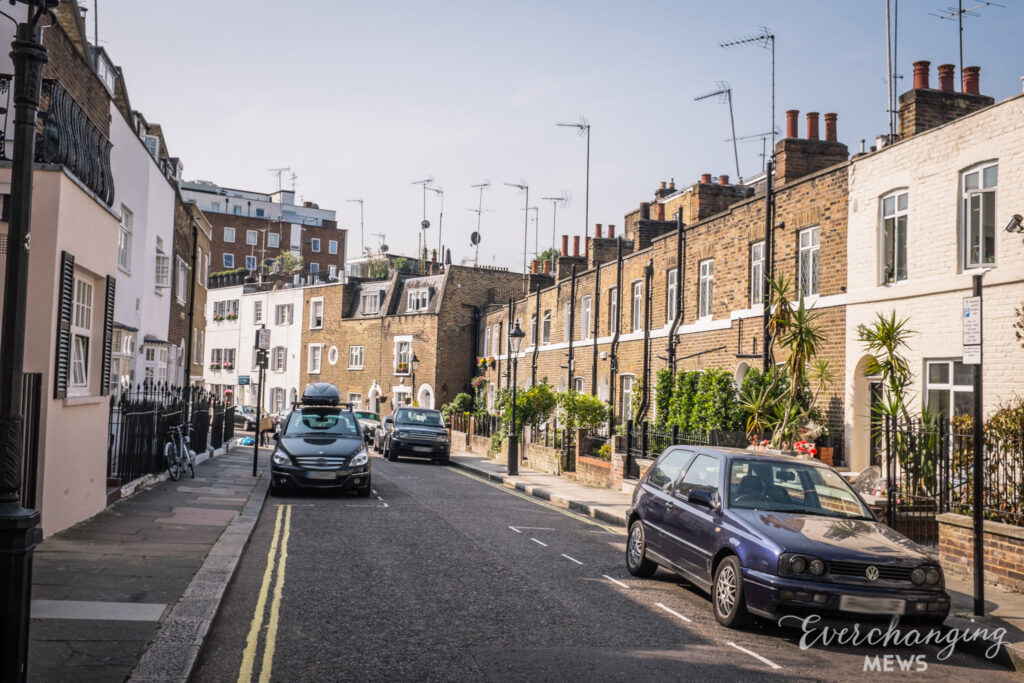
Sidney’s parents were Henry James Chalk, aged 29, a journeyman tailor, and Edinburgh-born Sarah Jane Rowe who was 28. The couple were married at St. Mary and St. Nicholas, the Parish Church of Wilton, Henry’s hometown, three miles west of Salisbury, in Wiltshire, on Monday, 5 May 1856. Sidney was their fourth child, daughters Mary Eliza and Alice Maud, and son Henry Alfred Chalk having arrived previously. By the time of Henry Alfred’s birth, the family were resident in London.
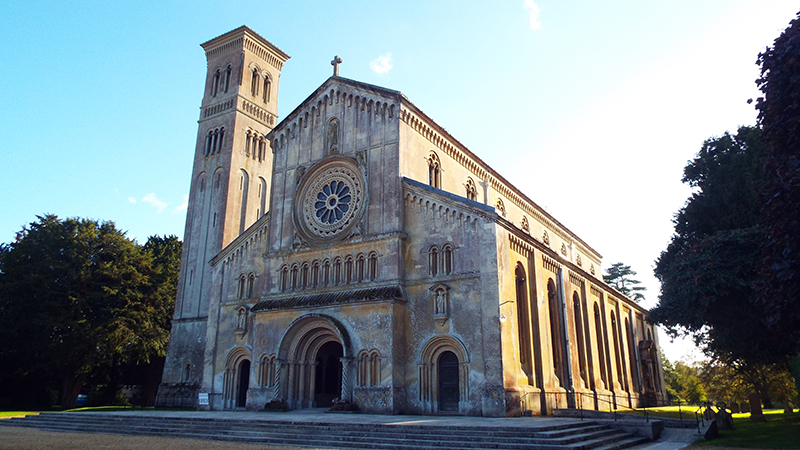
Henry Chalk was in business as a merchant and the family had moved again before a third son, William Arthur Chalk, was born on 2 March 1865 in the town of Birr, in County Offaly, in the centre of Ireland. Sadly, William died aged just two, on 7 June 1867, in Dublin. Further tragedy would follow in 1871, when Sarah Jane Chalk died, aged 37, in Kinsale, south of Cork, on the Irish coast.
During the summer of 1877 Henry returned to England to get married in Alderbury, back in his native Wiltshire, to another Sarah, a local girl by the name of Sarah Buckland. The newlyweds returned to Ireland and had two sons, half-brothers to Henry junior, and Sidney. George James Chalk was born in Dublin on 9 October 1879, and Percy Herbert James Chalk, at Newry, in the northeast of Ireland, on 13 May 1881. The family were on the move again before long and a final son, Douglas Buckland Chalk was born on 13 December 1883, at Portland in Dorset.
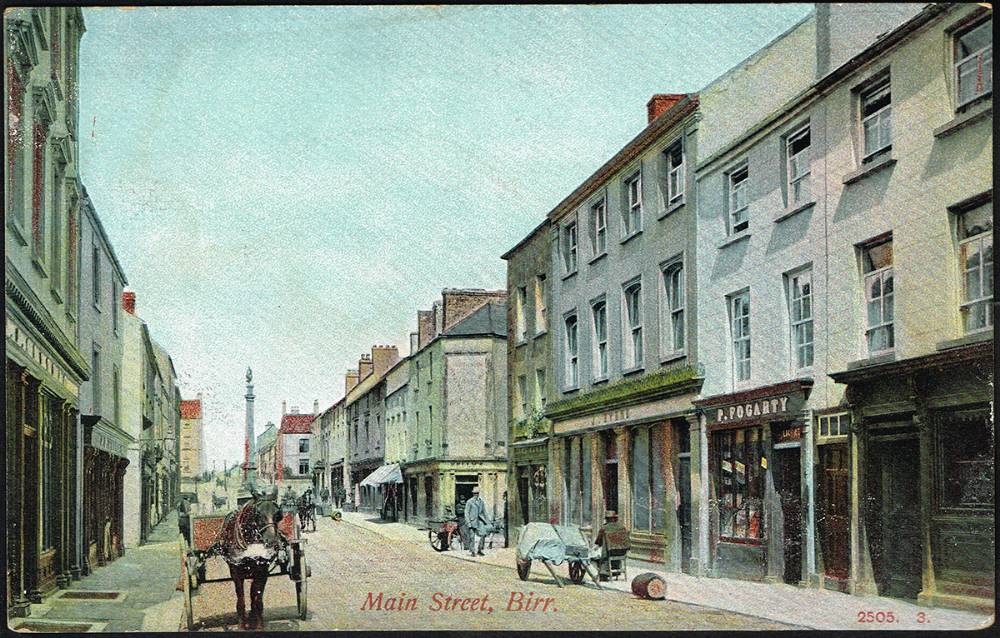
By this time, of course, Sidney had already long flown the nest. As evidenced by his appearances for Everton, he was already resident in Liverpool by early 1880 and would remain so for most of the decade to come. The 1881 census recorded him as working as an accountant and boarding with the family of a London-born bookkeeper by the name of John Mallabar, at 55 Kensington.
Chalk remained active in a sporting sense in at least one more capacity during the period after his brief tenure as Everton captain. Stanley Park had only been open for a little over a decade at this point. Designated as a green space for locals to enjoy, the boating lakes and gardens provided opportunity for exercise and relaxation and a variety of sporting activities took place on the well-kept lawns. The broad pathways which circumnavigate the playing fields to this day had originally been designed with horse-drawn carriages in mind, but local cyclists campaigned to have them resurfaced to suit their needs more adequately.
Cycling was fast becoming one of the nation’s most beloved and enthusiastically indulged-in outdoor pursuits and the residents of Liverpool were no different to anywhere else. Cycling clubs were springing up left, right and centre, and one of the most popular was the Anfield Bicycle Club, or the ABC, which was founded in 1879, the same year that St. Domingo’s Football Club adopted the name Everton. The ABC remains active to this day, albeit away from its Anfield origins.
In 1882 an ambitious local brewer by the name of John Houlding, already a prominent member of the Everton Cricket Club, who played their matches a short walk from Stanley Park on Walton Breck Road (credit to Tony Onslow, EFCHS), became President of the ABC. Houlding took on a similar position at Everton Football Club around this time, a role he would operate in with much success for a decade until the infamous dispute which saw the club relocate to Goodison Park in 1892.
Houlding’s second and final year as President of the ABC saw one S.A. Chalk became Club Treasurer, a role he filled for two years. Both gentlemen’s service is recorded for posterity in a 1956 book titled ‘The Black Anfielders: Being the story of the Anfield Bicycle Club 1879-1955’. ‘The Black Anfielders’ was the club nickname, their members being renowned for their all-black racing attire. In the ‘Editor’s Note’ at the start of the book, Sidney Chalk is mentioned in dispatches:
‘Look at the handbook of the Road Records Association (R.R.A.) and the Northern Road Records Association (N.R.R.A.) and note the number of Anfield records recorded therein. The Anfield is a founder member of both these bodies, and today very few clubs indeed can count their years with these splendid organisations back to 1888. And in S. A. Chalk the Anfield provided the very first secretary to the R.R.A.’

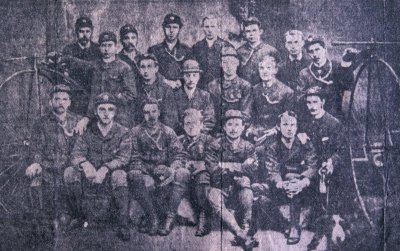
Around the time Sidney Chalk was taking on the secretaryship of the Road Records Association, he received the sad news that his older brother Henry, who had served for several years with the Merchant Navy, had passed away, on 27 May 1888, aged just 28. Two years later, on 26 August 1890, Sidney was present for the death of his father, Henry senior, who died aged 57 at Brahan Lodge in the village of Cookham, near Maidenhead in Berkshire. According to the death notice posted in the Cheshire Observer by the family on 30 August 1890,Brahan Lodge was the home of Henry’s son-in-law. It is unclear which of the Chalk children’s marital home this was. Sidney’s stepmother Sarah raised his three younger half-brothers alone. Thankfully all three lived long lives and Sarah saw out her years in Chester, where she passed away aged 80, on 29 February 1920.

Lloyds Weekly Newspaper of 12 April 1885 reported on a trial taking place at Guildhall police court in Westminster. A merchant by the name of Joseph Aplin Scott was charged with obtaining money under false pretences with intent to defraud. A key witness was an accountant by the name of Sidney Albert Chalk, whose report had uncovered the imbalance in reports which had allowed charges to be brought. Chalk was clerk to Messrs. Beazley, Browne and Co. at this point

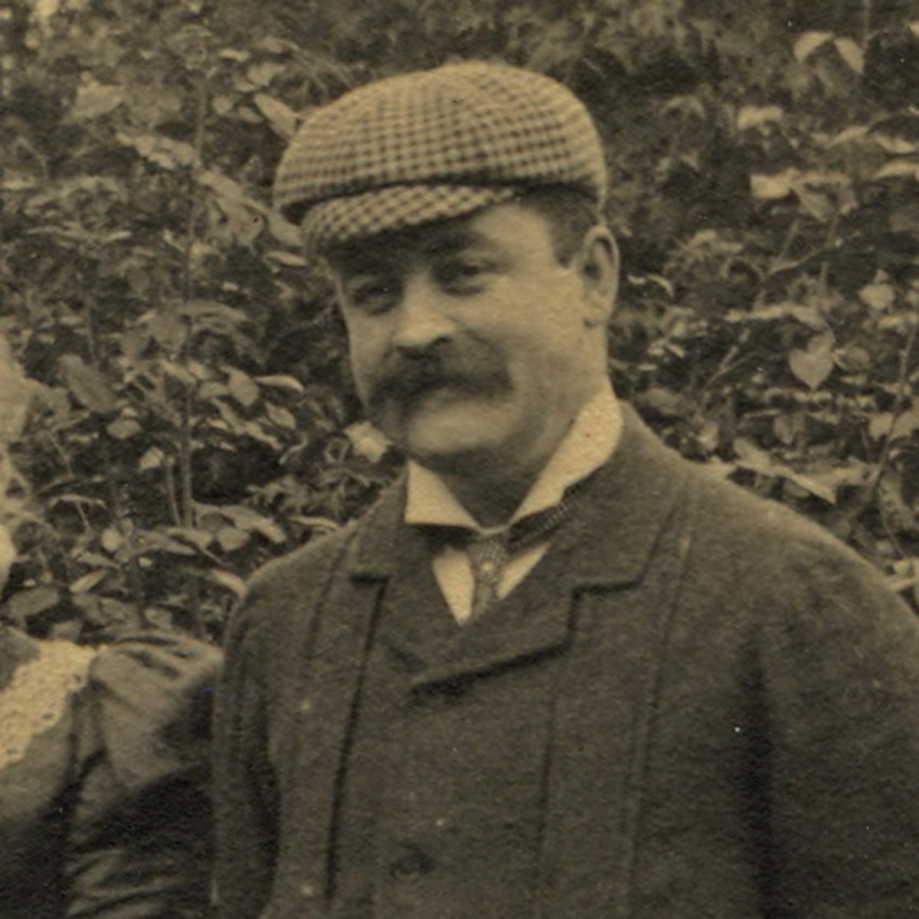
At some point, presumably in the late 1880s, Sidney returned to the city of his birth, and, on 24 March 1891 at Acton Parish Church in West London, he married Florence Emma Asser, who was born in Paddington, London on 26 January 1867. Chalk recorded his occupation as ‘merchant’ and the couple were both resident in Acton at this point, Sidney at 21 Milton Road, a short walk from Acton Central underground station. He had also become a member of the Freemasons in 1889.
The census of 1891 recorded the newlywed Sidney and Florence living at Brougham House, on Brougham Road, Acton, accompanied by Florence’s mother, Emma, and one servant. Notably, Sidney’s occupation was stated here as ‘East India Merchant’. The London Gazette of 27 October 1891 carried details of a business venture involving one Sidney Albert Chalk:
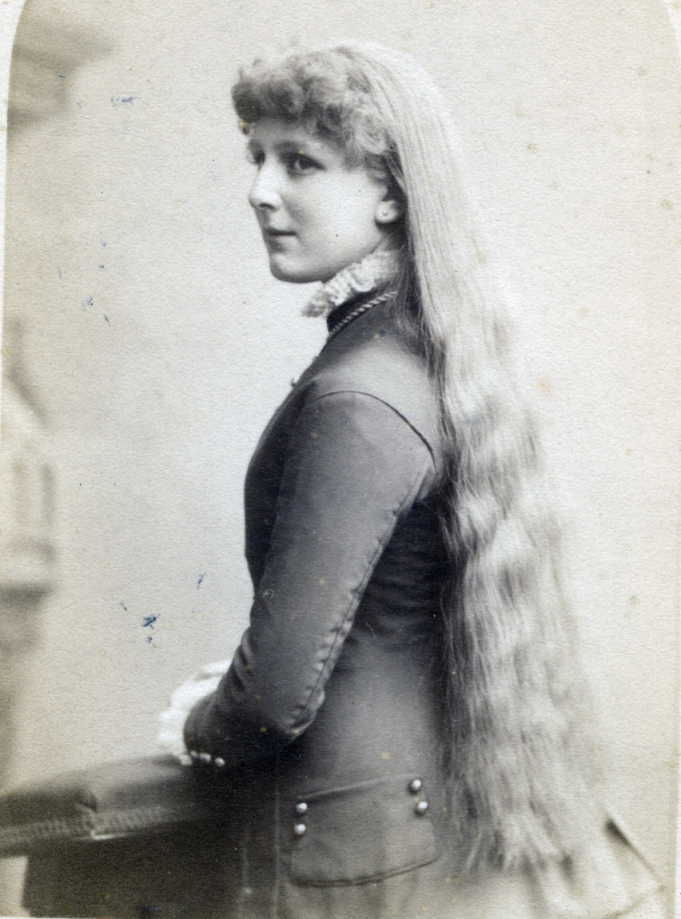
‘Notice is hereby given, that the Partnership heretofore subsisting between us the undersigned, William Digby, William Hutchinson, and Sidney Albert Chalk, carrying on business as East India Merchants and Bankers, at 25, Craven-street, Charing Cross, in the county of Middlesex, under the style or firm of Hutchinson and Co., has been dissolved, by mutual consent, as and from the 1st day of October, 1891. All debts due to and owing by the said late firm will be received and paid by the said William Digby and Sidney Albert Chalk, by whom the business will in future be carried on.
Dated this 12th day of October, 1891.
Wm. Digby
S. A. Chalk
W. Hutchinson’
On 25 February 1892, Sidney and Florence celebrated the birth of their only child, a son named for his father, Sidney Gordon Chalk. By this time the family had moved a few miles southwest of Acton, to a house called Coloba, in Twickenham.
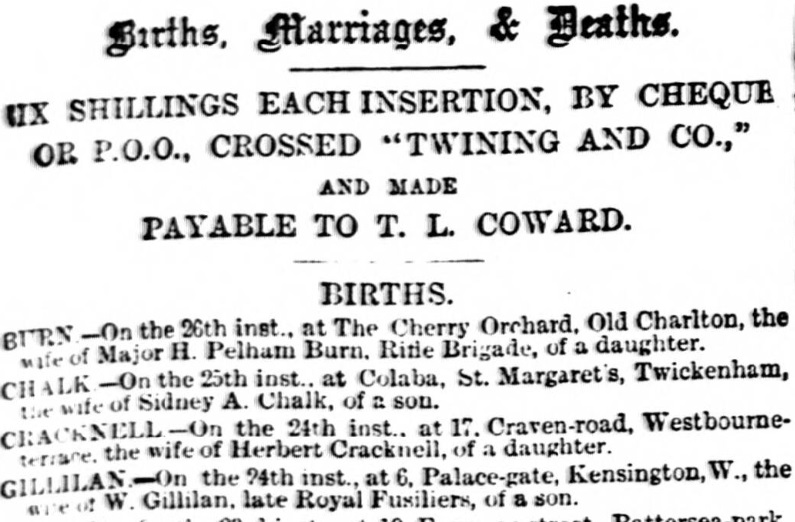
The Bangalore Spectator newspaper of Friday, 3 February 1893 published details of the Madras Electric Tramways Company, including a list of directors based in England, one of whom was ‘Sidney A. Chalk, Esq., of Messrs. Wm, Hutchinson and Co., London and Madras, Managing Director.’ Chalk’s partner William Digby ‘formerly of Madras’ and now Chairman of Wm. Hutchinson and Co., was also listed.
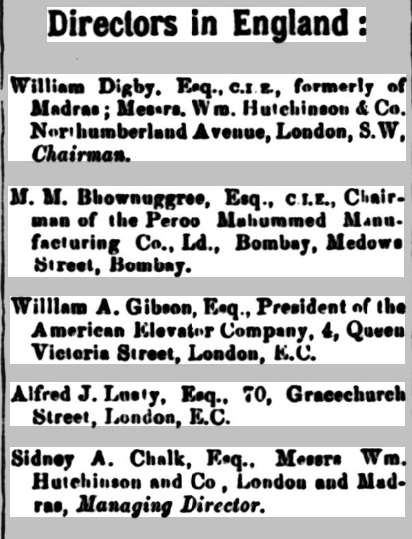

A word here from Sidney Chalk’s great grandson, Paul Chalk, of Ontario, Canada, who has carried out a lot of research into his family history:
‘Sometime after 1885, my great grandfather was a partner in the firm East India Agents, Merchants, and Bankers until September of 1894. After this he was part of a company that was involved with the first electric tram system in Chennai (formerly Madras), India. Trams in Chennai were operated between the docks and the inland areas, carrying goods and passengers.
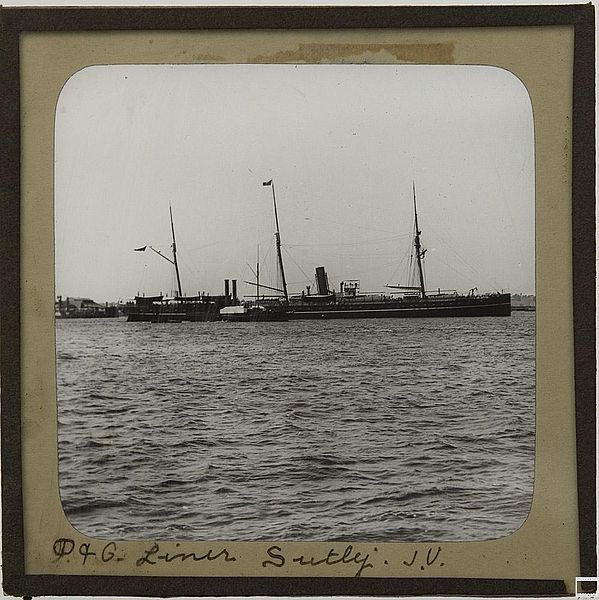
When the system began on 7 May 1895, it was the first electric tram system in the country. The trams could carry heavy loads and were very popular, transporting thousands of passengers daily. The route encompassed Mount Road, Parrys Corner, Poonamallee Road and the Ripon Building. At its height in 1921, there were 97 cars running on 24 kilometres of track. However, the tram company went bankrupt around 1950 and the system closed on 12 April 1953.’
On 6 September 1893 Sidney and Florence embarked as ‘saloon passengers’ on a trip to Bombay, aboard the Peninsular and Oriental (P&O) Steam Navigation passenger liner, ss Sutlej. Built at Barrow-in-Furness and launched in 1882, the ship was the last built of the P&O ‘River’ class, after Clyde, Shannon, Ganges and Thames, and was named for the Sutlej, one of the five main rivers of the Punjab. After a maiden voyage from London to Sydney, the ship thereafter served the line from London to Bombay. She later carried troops to the Transvaal in 1898, as part of the Boer War effort, before being sold and broken up at Marseilles in 1900.
At the time of Sidney and Florence’s arrival in Bombay, rioting had been ongoing between Hindu and Muslim groups in the city for several weeks. Temples had been destroyed and lives lost, as rival factions clashed over principles surrounding various means of conducting rituals and ceremonies at events such as the Muslim festival of Muharram. Colonial authorities in India were anxious to maintain order and the riots resulted in police being given greater powers to intervene in local disputes of this nature. The author Rudyard Kipling, who was resident in Bombay, the city of his birth, at the time, had referenced the tensions which had resulted in similar unrest in recent years in his short story compilation In Black and White, first published in 1888.
The Chalks were walking into a vibrant, colourful city, very different from their London home.
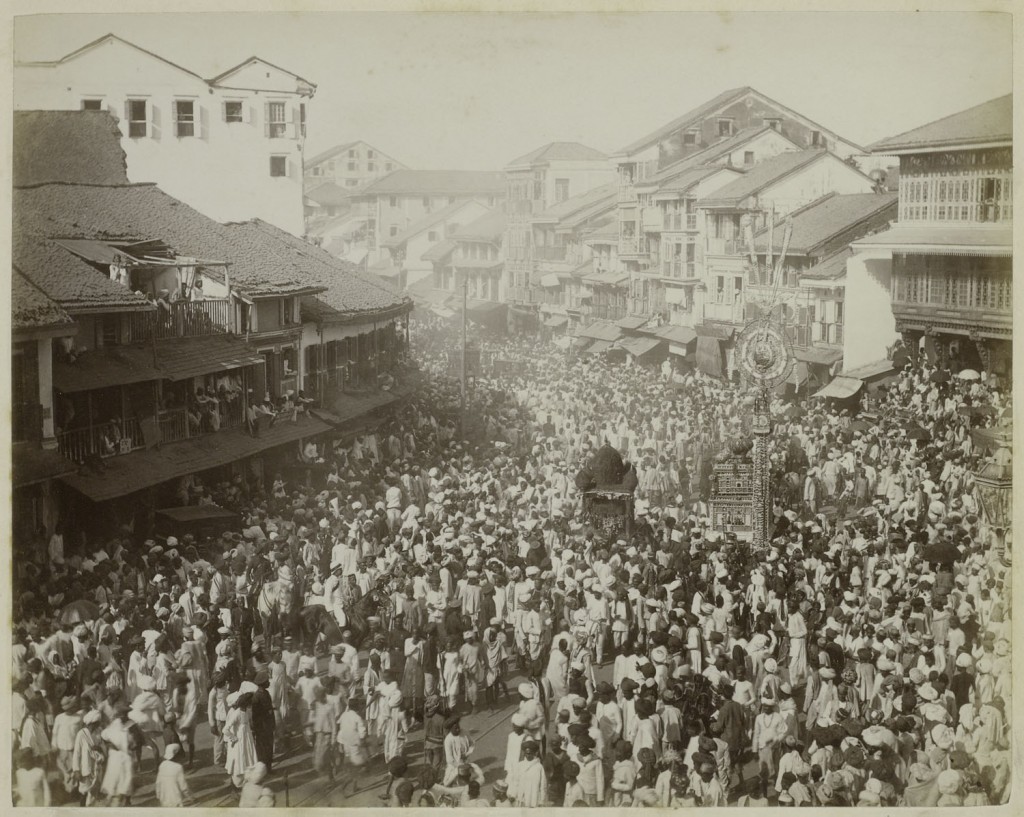
The Public Ledger and Daily Advertiser of 12 September 1894 included in its listings further East India trading interests. Sidney and his business partner William Digby now working with a third man by the name of Alfred Charles Colebrook Codd, and operating from premises at Trafalgar Buildings on Northumberland Avenue, Charing Cross. By 1897 the trio were resident at East Row in North Kensington. An 1898 directory recorded Sidney as operating independently from offices on Suffolk Street, off Pall Mall, to the west of Trafalgar Square.
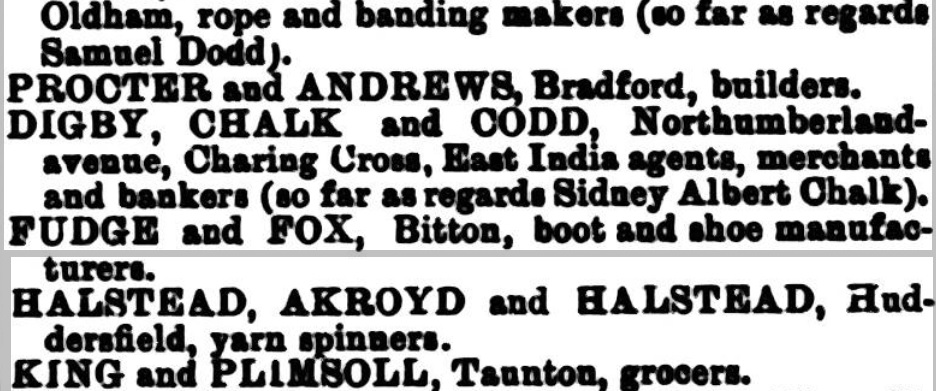
By the time of the 1901 census, the Chalk family had relocated to the south coast, setting up home at 7 Rattle Road in Westham, a few miles northeast of Eastbourne. Sidney is listed as ‘living on own means,’ which might suggest that his escapades with the East India Company had proven profitable. However, family lore from Paul Chalk suggests that Sidney’s fortunes may in fact have taken a downturn:
‘Sidney had been in business as an India Merchant with a partner, and the story went that this individual cheated him out of his money and the business.’
A directory for Sussex from 1905 lists Sidney Albert Chalk as a private resident of 4 Danesfield Terrace, Westham. That same year Sidney, by now having returned to work as an accountant, gave evidence at the Police Court in Eastbourne in the matter of an alleged case of embezzlement of funds by a local dairy manager, Chalk having audited the books of the business and a shortfall of a sum of £12 being discovered. Chalk appeared during the trial as a witness, as reported in the Eastbourne Gazette of 25 October 1901:
‘Mr. Sidney Albert Chalk, living at Westham, said – I was instructed to examine the firm’s books, which show that there is a balance of £12 due to the firm from the prisoner. I spoke to him about it on Tuesday, last week, at 55, Willingdon Road. I asked him if he had any cash in hand representing the difference. He replied, “I can’t understand it.”
I last saw the milk ledger on Wednesday, when it was quite whole. The books were not then in the condition they are in now.
Cross-examined – I believe you have borrowed money from the prisoner! No. Everything paid out of this book had a voucher. I could not tell whether a payment might have been made without a voucher.’
The suggestion here would appear to be that Chalk was being accused of having taken the £12 from the business. According to the report, the ledgers for the dairy appeared to have been tampered with, defaced or damaged in the intervening period between Chalk having audited them and the trial. However, no evidence appears to have come to light thereafter as to charges having been pressed against him.
The 1911 census return recorded ‘Sydney’ Chalk as a single man, resident at the Rowton lodging house on Arlington Road in Camden Town. Rowton Houses were a chain of hostels established by the Victorian philanthropist Lord Rowton, for affordable rental to working men as an alternative to the squalid conditions of traditional lodging houses of the era. His occupation was recorded as advertising clerk. Florence Chalk, meanwhile, was recorded as a married woman living on ‘private means’, with her mother, Emma, at 8, The Park, Ealing.
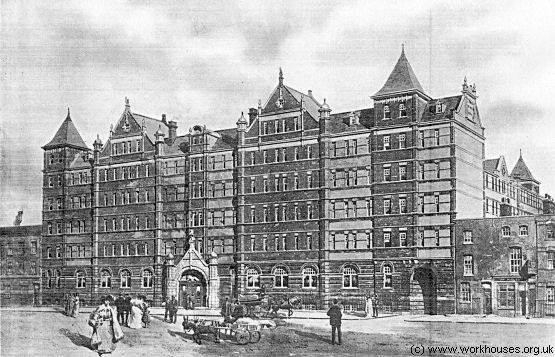
Author George Orwell wrote the following about Rowton Houses in his 1933 book Down and Out in Paris and London: [1]
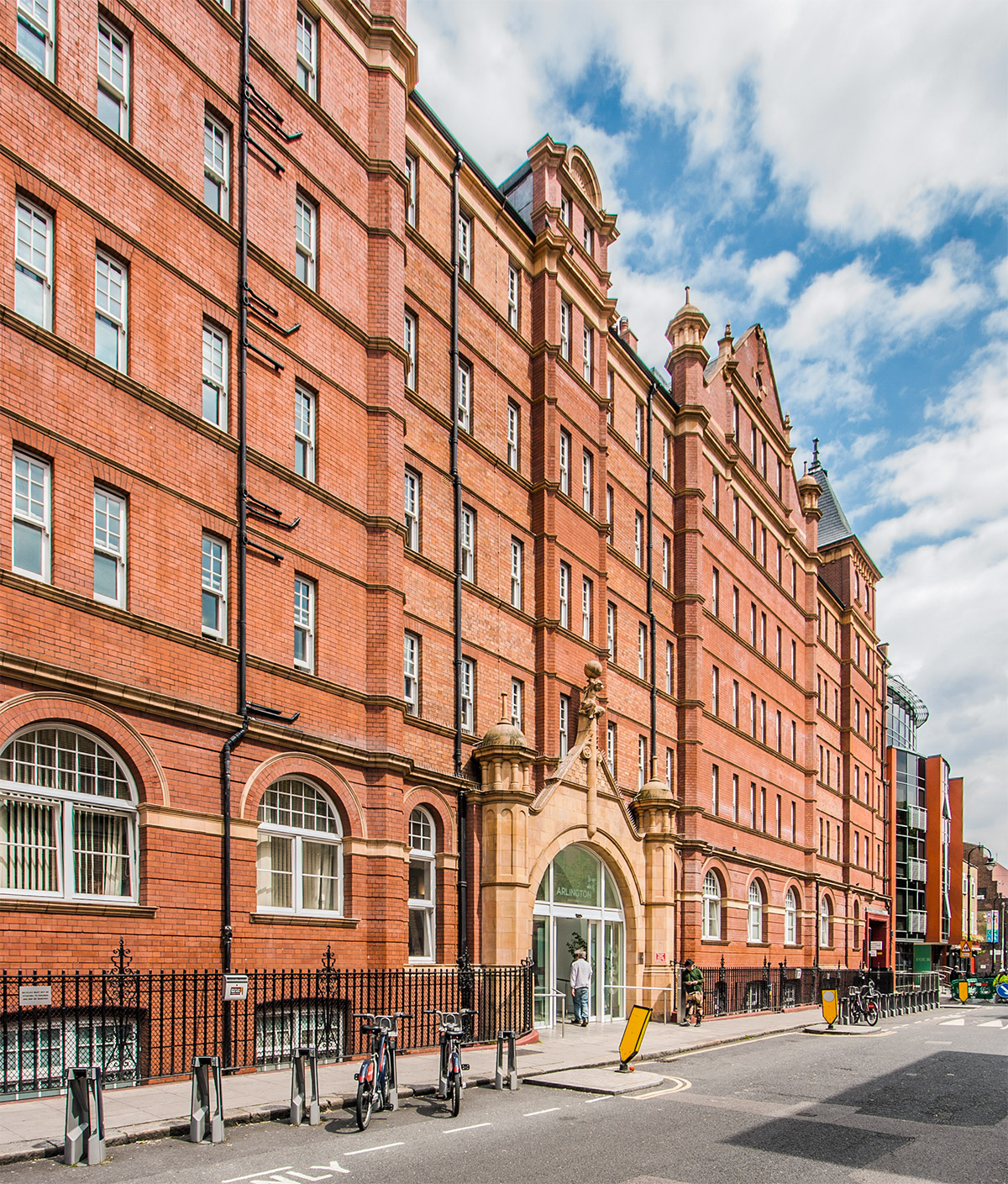
‘The best are the Rowton Houses, where the charge is a shilling, for which you get a cubicle to yourself, and the use of excellent bathrooms. You can also pay half a crown for a ‘special’, which is practically hotel accommodation. The Rowton Houses are splendid buildings, and the only objection to them is the strict discipline, with rules against cooking, card playing, etc.’
Arlington House was the last of the Rowton Houses to be constructed, in 1905, and, a Grade II listed building since 2011, is the only one still in use today, following extensive refurbishment in 2009. It provides shelter for up to 150 homeless, vulnerable and low-income tenants alongside conference facilities. In its heyday the building housed up to 1,200 men, a large percentage of whom were Irish immigrants to London, one notable resident being the writer and activist Brendan Behan. In 1984 both The Pogues’ album track ‘Transmetropolitan’ and Madness top 20 single ‘One Better Day’ referenced Arlington House. Over the years the building and its residents have also been the subject of award-winning photographic and documentary film projects.
Sidney Albert Chalk died at Charing Cross Hospital, from cancer of the oesophagus, on 14 July 1912, aged 50, although his death registration listed him as five years younger. Chalk’s occupation was recorded as ‘accountant’ and his address 210 Arlington Road, Camden Town, which suggests the family had returned to London by this time. He was buried at Brookwood Cemetery, on the outskirts of Woking in Surrey, on 19 July 1912.
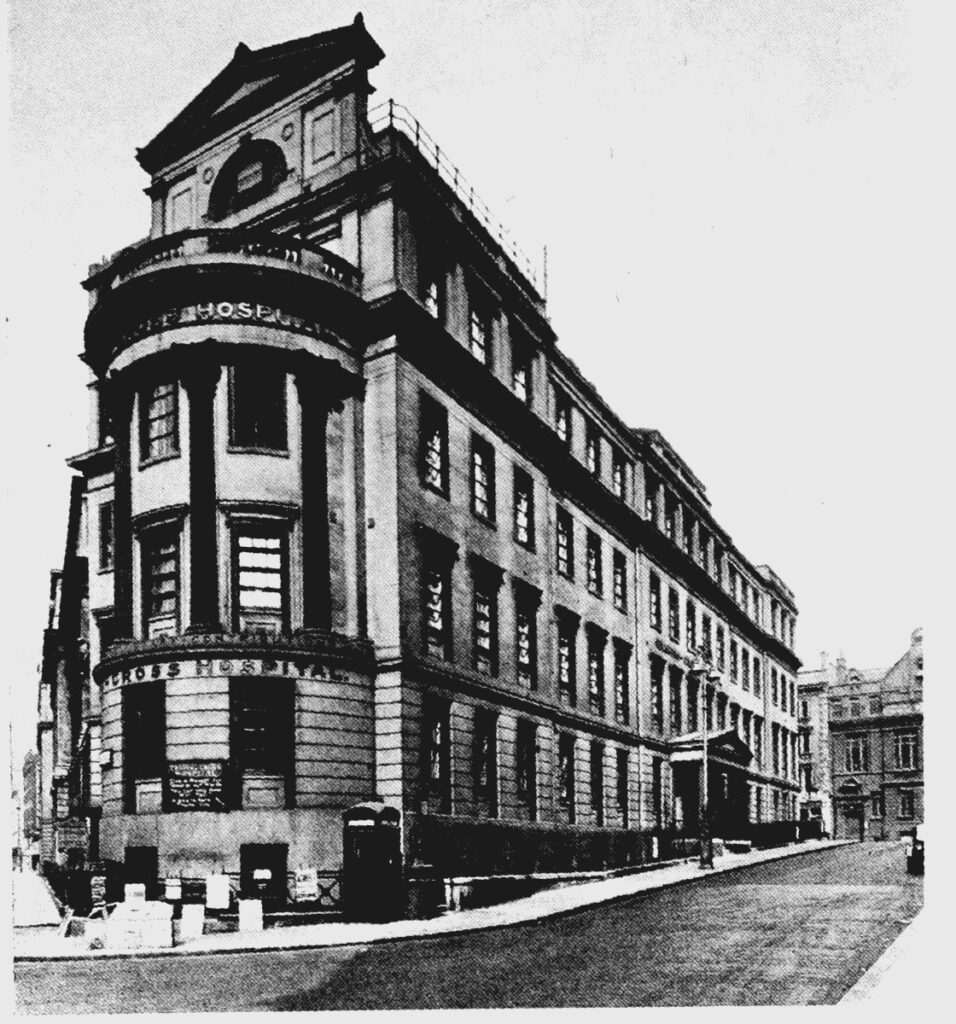

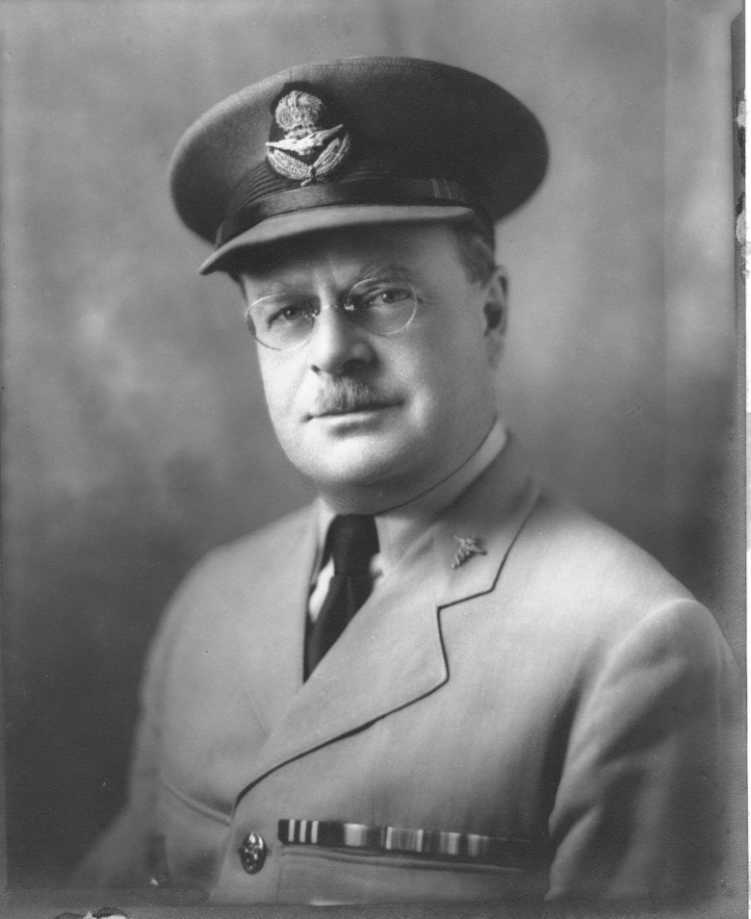
Having initially followed in his father’s footsteps by training as an accountant, Sidney Gordon Chalk went on to embark on a remarkable life and career. On 30 December 1914 he enlisted with the 3rd Battalion of the Canadian Mounted Rifles, part of the Canadian Expeditionary Force, as a Private (#108141). Frontline action followed in France and Belgium over the next 18 months prior to being awarded the Military Medal on 2 June 1916. Sidney was discharged from the army on 31 December 1917 and settled in London, Ontario, in Canada.
Having retrained and found work as teacher of neurology and anatomy at the University of Western Ontario, Sidney returned to England to marry Ivy Adelaide Barter, on 22 May 1923 at St. Martin’s Church in London. The couple’s first child, Gordon Connar Chalk, later known as ‘Don’, was born back in London, Ontario, the following year, and a daughter, Joan Barbara Chalk, followed in 1926.
In 1927 Sidney reenlisted with the armed forces, serving as a Lieutenant in the Canadian Militia, before working in psychiatric services in Ontario throughout the 1930s. When the Second World War commenced, Sidney enlisted in the Royal Canadian Air Force, where he served as Wing Commander. His mother Florence, who had joined her son in Canada in 1923, passed away in York, Ontario on 22 October 1944, aged 77. Sidney Gordon Chalk died on 7 August 1962 aged 70 and was buried at King Cemetery, Ontario.
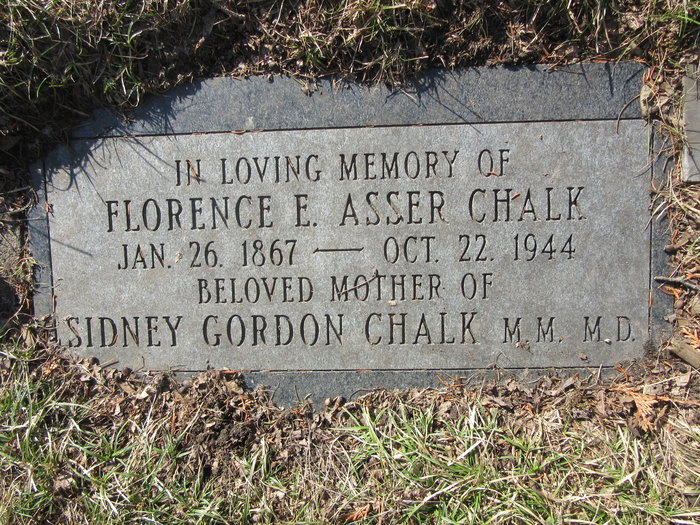
The Chalk family continues to thrive in Canada to this day and are aware of their ancestor’s fleeting, but nonetheless significant, early Everton Football Club connection.
Sidney Albert Chalk: known Everton appearances and goals:
*20 Dec 1879 (h) 6-0 v St. Peter’s (no team line-up available)
10 Jan 1880 (a) 0-2 v Birkenhead Association (captain, half-back)
*24 Jan 1880 (a) 4-0 v St. Peter’s (no team line-up available)
7 Feb 1880 (h) 0-2 v St. John’s, Bootle (captain, half-back)
*21 Feb 1880 (a) 0-4 v St. John’s Bootle (no team line-up available)
*28 Feb 1880 (a) ?-? v Wavertree (no team line-up available)
6 Mar 1880 (h) 0-2 v Birkenhead Association (captain, goalkeeper)
*13 Mar 1880 (a) ?-? v Liverpool Association (no team line-up available)
*there is a good chance that Sidney Chalk could have played in some or all of these fixtures, but records of team line-ups have not survived.
Chalk family photographs courtesy of Paul Chalk, great grandson of Sidney Albert Chalk.

